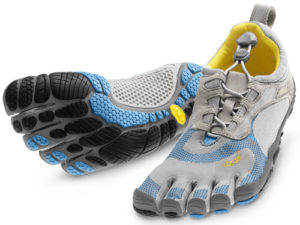 Ever since Christopher McDougall sought to salvage his own running career and in the process launched the minimalist running revival with his 2009 bestseller, “Born to Run,” fence-sitters have wondered: Does running barefoot — or nearly so — work?
Ever since Christopher McDougall sought to salvage his own running career and in the process launched the minimalist running revival with his 2009 bestseller, “Born to Run,” fence-sitters have wondered: Does running barefoot — or nearly so — work?
Quick catch-up: McDougall was an avid runner. Like many avid runners who entered the sport in the 1970s, he was an avid heel-striker. And like many avid heel-strikers as he entered middle age, he began enduring a host of injuries common to runners. Doctors told him to find something else to do, but McDougall wasn’t ready for long walks in the park. Besides, he wondered, running was once integral to our survival: running to catch a meal, running to avoid becoming a meal. Thousands of years had groomed us to run; only the last few hundred had tried to break us of the habit. And what about pockets of people around the world such as the Tarahumara in Mexico’s Copper Canyon who could run for days on end? Why could they run forever?
In searching for answers McDougall discovered that we were indeed born to run: We’d just forgotten how to do it. Rather than running on our forefeet, which have the bone structure to absorb the constant pounding of running, we’d been lulled by pricey running shoes with thick, wedge-shaped heels into striking our heels first. There’s little natural absorption in the heel; thus, over time that constant pounding takes a toll.
There’s been considerable debate on the matter, but probably the most telling endorsement of the “Born to Run” minimalist approach? The shoe companies that got us hooked on those cushy running shoes in the ‘70s all now offer minimalist shoes that cater too, and encourage, a forefoot strike.
Now weighing in on the issue: the American Council on Exercise. ACE enlisted the help of the University of Wisconsin La Crosse’s Exercise and Health Program to study the effectiveness and safety of minimalist running. Researchers John Porcari, Ph.D., and Caitlin McCarthy, M.S., recruited 16 injury-free female recreational joggers ages 19 to 25 and tested them running under three conditions: wearing the Vibram FiveFingers Bikilas, a barefoot-style running shoe; wearing “neutral” running shoes (New Balance 625); and while barefoot. The runners were then tested in the lab for “3-D motion analysis and measurement of ground-reaction forces.”
The results show that test subjects who ran properly in the FiveFingers — meaning they adopted a forefoot strike — did indeed endure less stress. Those who persisted with their heel-striking ways, however, were more prone to injury.
If you’ve been following the “Born to Run” debate, check out the full study here. Worry not: It’s relatively short and devoid of medicalese.
* * *
In other fitness news …
Do you have a fitness “problem”? Ever wonder if you work out too much? Of course you don’t — but maybe you should. According to The Nemours Foundation, you may be a “compulsive exerciser” if you:
- Refuse to skip a workout even when tired, injured or sick.
- Exercise out of obligation, rather than enjoyment.
- Double the length of a workout after missing one.
- Obsess over weight and burning calories, along with weight loss.
- Increase exercise to make up for eating more.
- Prioritize exercise above seeing friends and family, and participating in social activities.
- Allow intensity and frequency of exercise to affect self-esteem.
- Are unable to find satisfaction in physical accomplishments.
Stroke! Stroke! Finally, if you’re a guy and you’ve been trying to get pregnant (you know what I mean), try taking your boys for a walk. A study of 215 guys at Japan’s Yamaguchi U. found that those who exercised moderately exhibited the best sperm motility. (Translation for those who have never been handed a specimen cup: their sperm were better swimmers.) Interestingly, couch potatoes and the fitness obsessed both had weaker swimmers. Learn more here.
Battle of the bulge. Wanna lose that spare tire? Jogging beats weight lifting for losing belly fat, according to a recent study at Duke’s Medical Center. Duke studied 196 sedentary, overweight adults ages 18-70 over an eight-month period. Half ran the equivalent of 12 miles per week at 80 percent maximum heart rate, half did three sets of eight to 12 weight reps three times per week. Result: the aerobic exercisers burned 67 percent more calories than the resistance trainers.
“Resistance training is great for improving strength and increasing lean body mass,” according to lead author and Duke exercise physiologist Cris Slentz. “But if you are overweight, which two-thirds of the population is, and you want to lose belly fat, aerobic exercise is the better choice because it burns more calories.” More here.
So, a statistically significant percentage of 16 runners (female, aged 19-25) is supposed to convince me to buy blue shoes that will make me look like Aqua Man? I’d like to see a study done on who is healthier: 42 year old females who buy “cheap” sneakers yet walk 45 minutes a day VS. 25 year old females who spend a fortune on running equipment.
😉
For the initial study used by Vibram in the creation of the FiveFingers: http://barefootrunning.fas.harvard.edu/